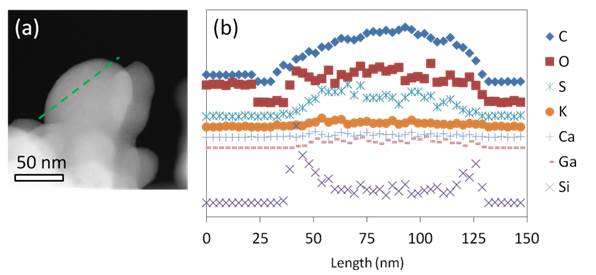IT-5-O-2917 Full Optical Properties of Carbonaceous Aerosols by Very High Energy Resolution Electron Energy-loss Spectroscopy
Carbonaceous aerosols have a strong impact on the global climate by direct radiative forcing via light absorption and scattering, and/or indirect radiative forcing via influencing cloud formation. It is critical to determine their optical properties to understand their contribution to direct radiative forcing. It is also important to understand their local chemical composition which would affect their role in cloud dynamics. By employing monochromated electron energy loss spectroscopy in a newly installed Nion UltraSTEM 100 at ASU with a sub 20 meV energy resolution, we can now determine the optical properties of carbonaceous aerosols over the full range of incoming solar radiation 200-2500 nm including the infrared. In addition, the compositional variation in aerosol spherules can also be studied.
Depending on the sources and the combustion conditions, different types of carbonaceous aerosols [1], can be present in the atmosphere. Here two types of aerosols, graphitic and amorphous carbon collected from East Asia, were investigated. Low loss spectra of these two types of aerosols were collected from Nion UltraSTEM 100 at 60 kV with an energy dispersion of 10 meV/channel giving a zero loss peak (ZLP) full width at half maximum (FWHM) of 40 meV. As shown in Fig. 1a, the EELS of graphitic and amorphous carbons are different, which is related to their different microstructure and chemical bonding. We found that the standard thin film formulation of Kramers-Kronig analysis can be employed to make accurate determination of the dielectric function for carbonaceous particles down to about 40 nm in size [2]. Figure 1b and c show the complex refractive indices (n-ik) of graphitic carbon spherules and amorphous carbon spheres over the photon wavelength range of 200-2500 nm. The absorption in the infrared range is obtained although it is smaller than that in the UV and visible range. The variances in the refractive indices of different particles were related to their variances in composition. We also found that on the surface of both graphitic spherule and amorphous carbon, there is a several nanometer thick layer rich in silicon and oxygen (Fig. 2). The nano-size coating could modify the chemical interactions of the carbonaceous aerosols, for example, by changing their ice nucleation properties.
References
[1] J. Zhu, P.A. Crozier, J.R. Anderson, Atmos Chem Phys. 13 (2013), p. 6359.
[2] J. Zhu, P.A. Crozier, P. Ercius, J.R. Anderson, accepted by Microsc Microanal.
The authors acknowledge support of the National Institute of Standards and Technology under Award 60NANB10D022 and the use of facilities in John M. Cowley Center for High Resolution Electron Microscopy at Arizona State University.

